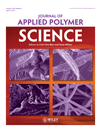Ionic salt permeability through phase-separated membranes composed of amphoteric polymers
Abstract
Amphoteric copolymers composed of hydrophilic poly(dimethyl acrylamide) and hydrophobic poly(dimethyl siloxane) formed phase-separated membranes. The hydrophilic and hydrophobic components formed continuous phase-separated domains in the membranes. The hydrated poly(dimethyl acrylamide) domains formed membrane-spanning pathways, which permitted an ionic salt to permeate the membranes. The permeability of the ionic salt through the amphoteric copolymer membranes was studied. On the basis of the results, the mechanism of salt transport could be explained by the free-volume theory, which was used for the analysis of diffusive transport in the hydrated, homogeneous membranes. The diffusion coefficient of the ionic salt increased exponentially as the volume ratio of the hydrophilic polymer to water [(1 − H)/H, where H is the degree of hydration] decreased in the membrane. It was possible to postulate that the diffusion of the ionic salt through the membranes was dependent on the free-volume fractions of water and hydrophilic poly(dimethyl acrylamide) domains in the membranes. © 2010 Wiley Periodicals, Inc. J Appl Polym Sci, 2011




